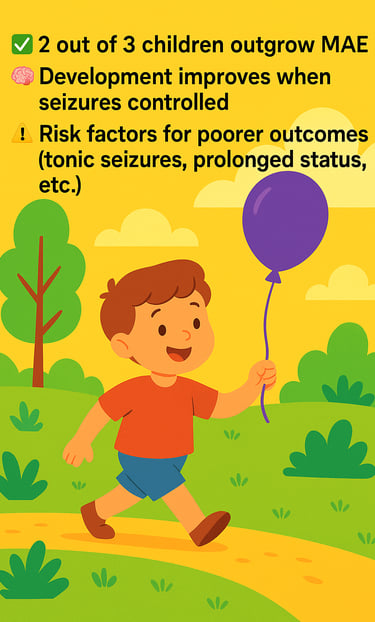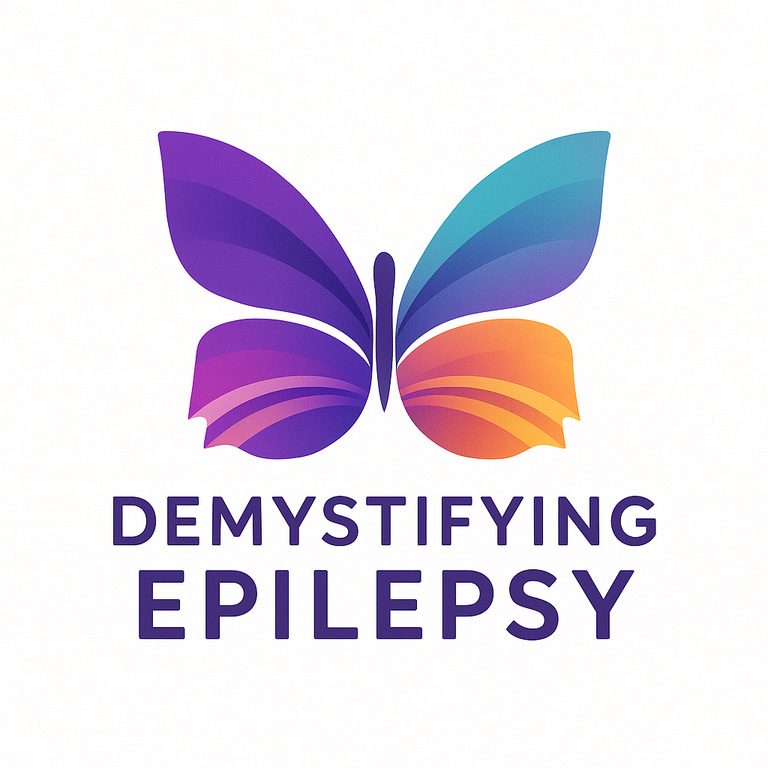Myoclonic Atonic Epilepsy (Doose Syndrome): Understanding a Rare but Treatable Childhood Epilepsy
Myoclonic atonic epilepsy (Doose syndrome) is a rare childhood epilepsy that can appear suddenly in children who were developing normally. This blog post breaks down what families need to know, how the seizures look, why early diagnosis matters, and which treatments offer the most hope. Through the story of Jack, a young boy whose life changed overnight, you’ll learn how MAE affects children, what causes it, and how many families find stability again with the right care. Whether you're a parent, caregiver, clinician, or advocate, this post offers a clear, compassionate look at a condition that’s often misunderstood but frequently treatable.
Dr. Clotilda Chinyanya
11/19/20255 min read


Jack’s Story: When Childhood Suddenly Changes
Jack had always been an energetic, curious five-year-old, the kind of child who ran everywhere instead of walking, who built towers taller than himself, and who giggled until he fell over. His development had been perfectly typical. He loved puzzles, dinosaurs, and coloring outside the lines.
One seemingly ordinary morning, Jack’s parents noticed something unusual. As he reached for a cup of juice, his body suddenly jerked, just for a second. He looked startled but then went back to playing. They dismissed it as early-morning clumsiness.
Later that week, Jack suddenly dropped to the ground while walking across the living room. No tripping, no warning, his muscles simply gave way. He stood up confused, insisting he was fine, but his parents felt a knot in their stomachs. Something wasn’t right.
Over the next days, the episodes multiplied. Brief jerks. Sudden collapses. Long moments where Jack stared ahead, unresponsive. And then one morning, he had a generalized seizure that left him exhausted and terrified.
His parents rushed him to the hospital. After detailed history-taking, EEG testing, and a neurological evaluation, Jack’s medical team gave a diagnosis his parents had never heard before:
Myoclonic atonic epilepsy - formerly known as Doose syndrome - A rare epilepsy syndrome that often appears suddenly in young children who were previously developing normally. The diagnosis felt overwhelming. But it also provided direction. With early treatment and support, Jack’s story, like many children with this condition could change for the better.
What Is Myoclonic Atonic Epilepsy?
Myoclonic atonic epilepsy (MAE) is a rare and complex childhood epilepsy syndrome that typically appears between 2 and 6 years of age, though the range can be from about 6 months to 8 years. It affects boys more often than girls, and it accounts for about 1–2% of childhood epilepsy cases.
It was first described in 1970 by Dr. Herman Doose, which is why it was previously called Doose syndrome.
Today, the preferred name is myoclonic atonic epilepsy, because it more accurately describes the main seizure type.
Although the seizures can be dramatic and the onset abrupt, this syndrome has one important feature:
✅ About two-thirds of children eventually outgrow the epilepsy.
What Do the Seizures Look Like?
Children with MAE often have multiple generalized seizure types, which can appear quickly over days or weeks.
1. Myoclonic-Atonic Seizures (the hallmark)
These come in two parts:
A myoclonic jerk — a sudden, brief muscle contraction
Followed by atonia — a sudden loss of muscle tone
This combination leads to “drop attacks”, where a child may suddenly fall from standing, sitting, or even mid-step. These can cause injuries and can be frightening for families.
2. Absence Seizures
Brief staring spells where awareness is impaired. These can be subtle and easily missed early on.
3. Myoclonic Seizures
Quick, shock-like jerks without a fall.
4. Generalized Tonic-Clonic Seizures
Often one of the first seizure types parents notice.
5. Tonic Seizures (in some cases)
These may appear later in the illness and are associated with a more challenging prognosis.
Status Epilepticus
About one-third of children experience episodes of prolonged or repeated seizures, including non-convulsive status, where the child appears confused, unsteady, or “not themselves” for extended periods.
What Causes MAE?
The exact cause is often unknown, but research shows a strong genetic influence.
About one-third of children have a family history of seizures.
Many have no identifiable gene mutation, but when genetic variants are found, they often involve genes related to brain excitability.
MAE is considered part of a spectrum of genetic epilepsies with febrile seizures plus (GEFS+).
Importantly:
✅ MRI scans are typically normal
✅ Prior development is normal in about two-thirds of children
How Is Myoclonic Atonic Epilepsy Diagnosed?
Diagnosis relies on a combination of:
Clinical Description
The presence of myoclonic-atonic (drop) seizures is key.
EEG (Electroencephalogram)
May be normal at first
Later shows generalized spike-wave activity, often in the 2–5 Hz range
EEG patterns such as slow spike-wave or generalized fast activity can help predict prognosis
Neuroimaging
Brain MRI is normal, helping differentiate MAE from structural causes of epilepsy.
Genetic Testing (in selected cases)
Not required for diagnosis, but occasionally helpful.
Treatment Options
Treatment often involves a combination of therapies. Because seizure types vary and can be frequent, early management is crucial.
1. Anti-Seizure Medications
Anti-seizure medications are usually the first treatment tried. Some children respond, but many have drug-resistant seizures, especially early in the illness. Treatment choices depend on the child's seizure types.
Important note:
Some medications can worsen myoclonic or atonic seizures, so the care team must choose treatments carefully.
2. Dietary Therapies
Dietary therapies are often highly effective for MAE and are recommended early, especially when seizures remain frequent.
✅ Ketogenic diet
✅ Modified Atkins diet
Studies consistently show improvement in both seizure control and overall functioning for many children.
3. Rescue Medications
Used for:
Long seizures
Clusters of seizures
Non-convulsive episodes where the child is unusually sleepy, drooling, or unsteady
Families are taught how and when to administer rescue treatment and when to seek emergency care.
4. Advanced or Adjunctive Therapies
When medications and diet are not enough, additional strategies may be considered:
Steroid therapies (in selected cases)
Cannabidiol formulations for treatment-resistant epilepsy
Corpus callosotomy, a surgical procedure used only in severe, persistent cases with dangerous drop attacks
Vagus nerve stimulation (VNS) has been attempted but results are mixed.
How Does MAE Affect Development?
Before seizures begin, most children have normal development.
However, when seizures are frequent—especially drop attacks, myoclonic clusters, or prolonged episodes—children can experience:
Developmental regression
Behavioral changes
Sleep disruption
Attention and executive function difficulties
Ataxia (coordination problems)
The good news:
✅ When seizures improve, many children begin to regain skills.
✅ Cognitive and behavioral recovery often follows.
Long-Term Outlook
Outcomes vary widely, but research consistently shows:
✅ Two-thirds of children eventually outgrow the epilepsy
✅ Many can discontinue medication after remission
✅ Development often improves once seizures are controlled
About one-third continue to have seizures or developmental challenges. Predictors of more difficult outcomes include:
Tonic seizures
Recurrent non-convulsive status epilepticus
Certain EEG patterns
Very frequent seizures early in the illness
Jack’s Journey: From Crisis to Hope
Jack’s family began a long but hopeful journey.
At first, Jack’s seizures were intense and frequent. Anti-seizure medications helped somewhat, but the drop attacks continued unpredictably. He became hesitant to run and play. His parents watched nervously every time he climbed onto the couch or tried to jump.
Then Jack’s care team introduced dietary therapy alongside his medications. The change wasn’t immediate, but within a few months, seizures began to decrease. Jack’s laughter returned. His balance improved. He slept better. And eventually, slowly but surely, his seizures faded.
Two years after his diagnosis, Jack’s neurologist shared the words his family had hoped for:
“He’s doing beautifully. It may be time to start talking about tapering treatment.”
Today, Jack is back to building towers, running everywhere instead of walking, and coloring boldly outside every line. His parents still watch him closely—but the fear has softened. They know that early diagnosis and coordinated treatment changed the trajectory of his story.
Why Awareness Matters
Myoclonic atonic epilepsy can look confusing—sudden drops, quick jerks, blank stares, or clusters of subtle events that don’t resemble the seizures most people imagine. Because of this, many families spend weeks or months unsure of what is happening.
Greater awareness means:
✅ Faster diagnosis
✅ Faster access to effective treatment
✅ Fewer injuries from undetected drop attacks
✅ Better long-term developmental outcomes
✅ More support for overwhelmed families
No parent should have to navigate those first terrifying weeks alone.
Final Thoughts
Myoclonic atonic epilepsy (formerly Doose syndrome) is rare, sudden, and deeply challenging—but also treatable. With early recognition, personalized therapy, and ongoing support, many children not only regain stability but thrive.
Jack’s story is just one example of the resilience of children and the power of early intervention. Every child deserves the same chance for recovery, growth, and a hopeful future.
Further Reading:
Choose knowledge:
